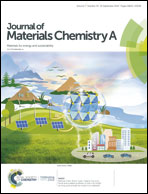Design, synthesis and lithium-ion storage capability of Al0.5Nb24.5O62†
Abstract
Nb16W5O55 is considered as a promising anode material for lithium-ion batteries (LIBs) due to its high safety, good cyclability and high rate performance. However, it has not been practically used since it suffers from its limited capacity. Here, we demonstrate the design and synthesis of a tungsten-free and niobium-rich Al0.5Nb24.5O62 anode material having a very large theoretical capacity of 400 mA h g−1 and a stable shear ReO3 crystal structure. Both Al0.5Nb24.5O62 microsized particles (Al0.5Nb24.5O62-M) and porous microspheres (Al0.5Nb24.5O62-P) were successfully synthesized. In situ X-ray diffraction indicated the intercalated characteristic of Al0.5Nb24.5O62 and revealed the Li+ insertion into/extraction from its (010) crystallographic planes with high structural stability. Consequently, Al0.5Nb24.5O62-P exhibited a large practical capacity (321 mA h g−1 at 0.1C) and good cyclability (90.0% capacity retention after 500 cycles at 10C). In addition, Al0.5Nb24.5O62-P exhibited significant intercalation pseudocapacitive behavior (86.1% pseudocapacitive contribution at 1.1 mV s−1), high rate performance (192 mA h g−1 at 10C), high initial coulombic efficiency (94.9%) and safe working potential (∼1.68 V). Al0.5Nb24.5O62 also performed well in a LiNi0.5Mn1.5O4//Al0.5Nb24.5O62-P full cell. These research results indicate that Al0.5Nb24.5O62 is a practical anode material for high-energy, stable, fast-charging and safe LIBs.



 Please wait while we load your content...
Please wait while we load your content...